Read Reviews
The Best Log Splitters
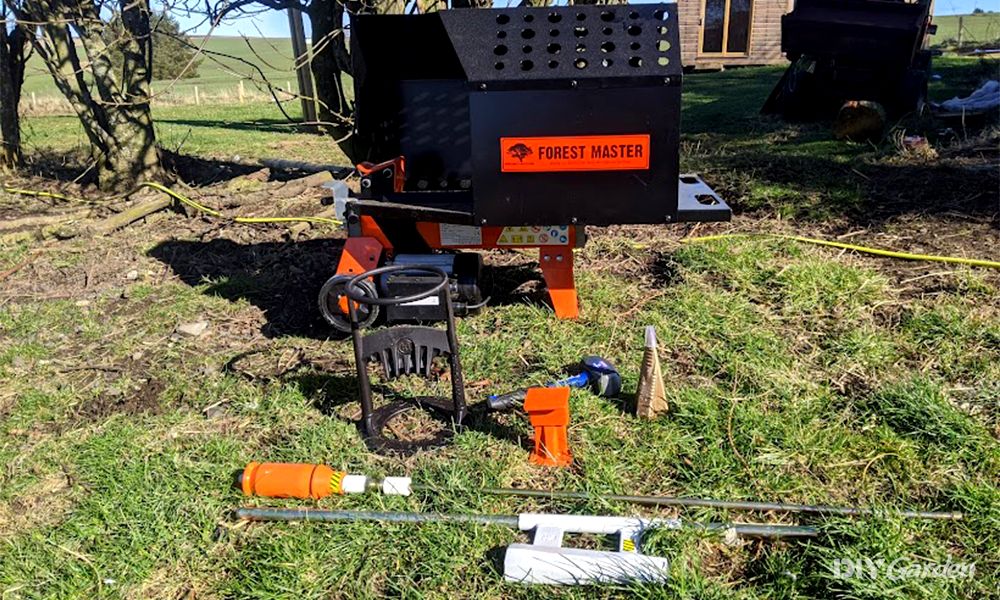
Making firewood can be tough work. A log splitter will save you a lot of time and energy. We’ve tested the most popular tools to help you make the right choice. We believe the UK’s best electric log splitter is the Forest Master FM5 Log Splitter. The best manual log splitter is the Swedish Log Splitter. Both have genius engineering and require minimal effort to use.
-
Best electric log splitter - Forest Master FM5 Log Splitter
-
Best manual log splitter - Swedish Log Splitter
-
Best budget log splitter - Rolson 10780 Wood Grenade Log Splitter
-
Best for making kindling - Kindling Cracker Firewood Kindling Splitter
-
Best budget kindling splitter - Forest Master USBB Firewood Kindling Log Splitter
Log Splitter Reviews
1. Forest Master FM5 Log Splitter
Best electric log splitter
- A one-piece machine that doesn’t need to be assembled (although its safety cage does)
- A compact and lightweight design makes this log splitter convenient to move around and store
- Has a powerful 2200W motor that provides 5 tons of pressure - it’ll split a 30cm log in less than 9 seconds
- Works well on both hardwood and softwood, as well as wet wood and dry wood
- Designed in a way that keeps the user as safe as possible
- The safety cage is difficult and time-consuming to assemble
- The power cord is only 175cm long - you may need an extension lead
- You’ll need to buy or build a stand to use this electric log splitter on, unless you want to be down on your hands and knees
- Splitter Type
- Electric hydraulic
- Log Type
- Medium to large
- Assembly?
- Yes
- Weight
- 32kg
- Assembly
- 3
- Design
- 5
- Performance
- 5
- Ease of Use
- 5
- Safety
- 5
- Noise
- 5
- Value for Money
- 5
While manual wood splitters may be cheap to buy, free to run, and are eco-friendly to boot, it’s hard to beat a hydraulic, electric log splitter if speed and power are what you need. If you’re looking for a hydraulic log splitter for domestic use, the Forest Master FM5 Log Splitter appears to be a popular option.
But is this electric log splitter really worth the investment? Luckily, I had a huge pile of logs waiting to help me answer this question.
The log splitter itself is a single-piece item that’s ready to be used straight out of the box. However, if you’re in the EU, the law requires you to assemble the safety cage, which takes a lot of time and patience. Have a look at some images online to work out how it’s done, since the instructions aren’t very helpful.
As electric log splitters go, this machine is very compact and lightweight. At the same time, it feels sturdy and high-quality. Its two wheels give it good portability, and its 175cm power cord offers flexibility. The only downside is its height. Being compact, this log splitter is just 45cm tall when standing on the ground, so you’ll need to use a stand or a bench of some sort. To be fair, Forest Master does sell a stand separately to help with log splitting.
The FM5 Log Splitter uses a 2200W motor to deliver 5 tons of pressure. This was ideal for the logs that I had – it split them all cleanly each time. This 5 ton log splitter handled knotty logs without a problem, and there wasn’t really a difference when splitting wet and dry wood. Its 9 second cycle time may seem a little slow to some, but if you’re quick at putting a new log in, you don’t actually need to wait this long.
This electric log splitter isn’t overly complicated in any way. There’s only one button to press and one lever to push – it can easily be used by one person, although it does require both hands to operate.
The safety cage does make using the log splitter a little more cumbersome to use, as well as heavier to move and awkward to store, but this is obviously a key safety feature. It’s quite an important one, particularly if you’re working with knotty wood, as it’ll stop any wood from flying back out and hitting you during the log-splitting process.
Compared to the manual log splitters that I tested, this one is obviously a lot louder, to the point where Forest Master recommends wearing ear protection when using it. However, considering it has a 2200W motor, I didn’t find it to be particularly loud, although any nearby neighbours may disagree!
Bearing in mind all that it offers, this hydraulic electric log splitter comes in at a great price. Not only are you paying for high-quality parts and solid manufacturing, but you also get a machine that’s quite fun to use!
If you’re looking to make your first foray into hydraulic splitters, then the Forest Master FM5 Log Splitter is a great place to start. It’s the best electric log splitter and is ideal for anyone who need to regularly split wood for small to medium wood-burning stoveswe – it’ll split wood efficiently and easily, with minimal effort required on your part.
Did you find this review helpful?
2. Swedish Log Splitter
Best manual log splitter
- Easy assembly takes just 10 minutes, with clear instructions to follow
- Has a very clever and innovative design that makes it easy and effortless to use
- Can split logs of all sizes, making it very versatile
- Can also be used to produce kindling from split logs
- Works well with both green and dry wood, as well as knotty logs
- Made from high-quality metal that’ll last the years
- A little pricey (but well worth the money!)
- Splitter Type
- Manual
- Log Type
- All sizes
- Assembly?
- Yes
- Weight
- 9kg
- Assembly
- 5
- Design
- 5
- Performance
- 5
- Ease of Use
- 5
- Safety
- 5
- Noise
- 5
- Value for Money
- 5
The Swedish Log Splitter promises to take the effort out of log splitting yet doesn’t require electricity to run. Even better, it claims to be able to produce both split logs and kindling. My job was to find out how genuine these promises were.
There was a little bit of assembly involved with this manual log splitter, but it only took about 10 minutes to put everything together. You’ll need to find yourself a base log to attach the log splitter to, so choose something that allows you to work at a comfortable height. You’ll also need a drill in order to use the 20mm drill bit supplied. Other than that, everything needed for assembly is provided.
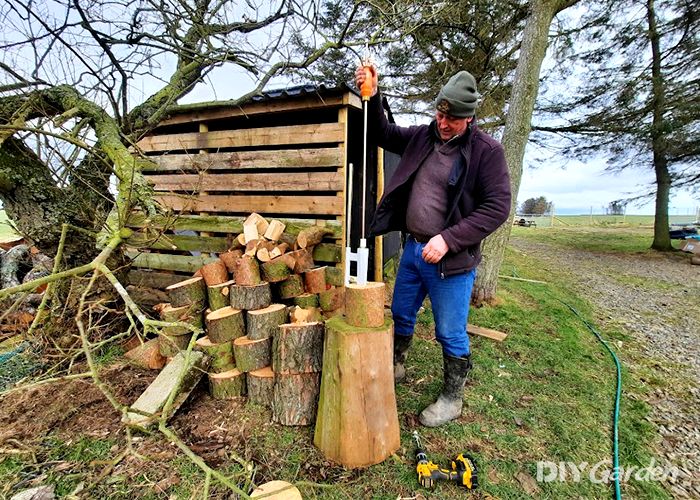
So, how does this log splitter hold up when it comes to performance? In my experience, very well. I used this log splitter on logs of all sizes, with the largest being around 14 inches in diameter. It also performed fantastically on both green and dry wood, and, as promised, it was able to split logs as well as smaller pieces of kindling.
What was most impressive was how easy it was to use this log splitter. Simply dropping the weight down the pole a few times is all you really need to do to split most logs. Larger logs, as well as knottier logs, may require you to push the weight down the pole a little more forcefully, but the amount of effort needed really is minimal.
While there weren’t any stand-out safety features incorporated into this log splitter, its simplicity means that these aren’t really needed. Keep your hands away from the log and follow the safety tips in the instruction manual and you should be just fine! I wouldn’t say that ear protection was necessary either; this log splitter is a little quieter than an axe, so it’s not particularly noisy.
Don’t let the price of this log splitter put you off. Sure, you may be able to purchase a manual log splitter for a lot less, but those still require a fair bit of force and effort on your part, whereas this one doesn’t. It’s also versatile enough to be used on logs of any size – this log splitter happily split logs that I would usually need a hydraulic splitter for, yet it costs much less! In my opinion, this log splitter offers fantastic value for money.
All in all, this is a log splitter that would suit just about everyone, and that’s not something that you can say about most other wood splitters! Whether you only occasionally split logs but want a tool to make that dreaded task easier (and even fun!), or you split logs regularly and are looking for a way to speed up the process, the Swedish Log Splitter would be a great investment.
It’s an excellent log splitter, and the best manual log splitter thanks to its ingenious engineering.
Did you find this review helpful?
3. Rolson 10780 Wood Grenade Log Splitter
Best budget log splitter
- No assembly required - it’s ready to use straight out of the box
- A quality and durable tool that’s made from heat-treated iron - it’s not going to break easily, so long as you use it correctly
- Very simple to use - no instructions necessary!
- Performs well on small to medium logs
- Can split both green and dry wood, as well as hardwood and softwood
- Comes with a rubber tip to prevent accidents when not in use
- Very reasonably priced compared to other log splitters
- Quieter than an axe, and also quieter than many other log splitters
- If you don’t already have a sledge hammer, you’ll need to purchase one in order to use this log splitter, which adds to its cost
- Can throw out a fair amount of splinters, making eye protection advisable
- You’ll need to use a significant amount of strength to split large logs with this tool
- Doesn’t work well on logs that are too much taller than 17.5cm
- Difficult to use on logs that are uneven on both ends, since you need the log to sit steadily on its own
- Splitter Type
- Manual
- Log Type
- Small to medium
- Assembly?
- No
- Weight
- 0.857kg
- Assembly
- 5
- Design
- 5
- Performance
- 5
- Ease of Use
- 4
- Safety
- 5
- Noise
- 5
- Value for Money
- 5
Manually splitting logs with an axe can be extremely tiring, but the Rolson 10780 Wood Grenade Log Splitter promises to help you make light work of the task. According to the brand, using this uniquely-shaped tool with a sledge hammer will enable you to easily split a log four-ways with just a few taps, so I was eager to find out how true this claim really was.
If you’re looking for a log splitter that doesn’t require any assembly whatsoever, then this is it. Out of the five log splitters that I tested, this one was the fastest to put together. All you have to do is remove the rubber tip and you’re good to go!
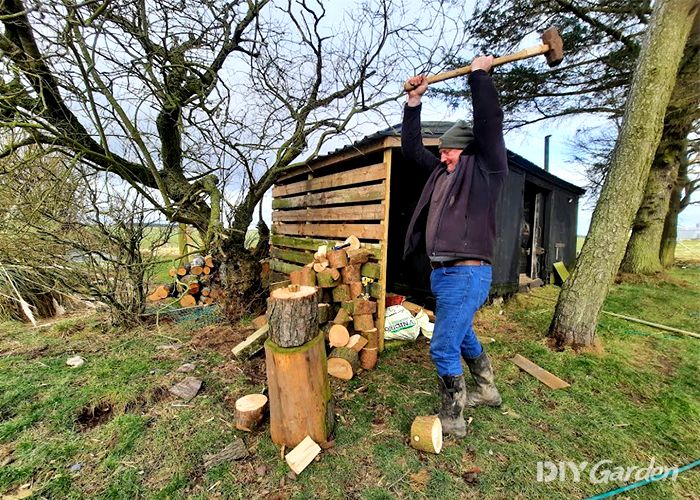
How well this log splitter works depends on how you’re using it, as well as what you’re using it on. Different hammers will give you different results. Something small, like the Faithfull FAIFG4 4lb Club Hammer, is all you need if you’re splitting small logs. However, if you’re working with medium or large logs, which this log splitter is capable of handling, then go with a bigger hammer. Keep in mind that, while this log splitter handled every diameter of log that I threw at it, it struggled with logs that were significantly taller than its own height (17.5cm). I also found its four-way claim to be false – in my experience, it splits wood into two instead.
This log splitter is much easier to use on smaller logs. As mentioned, it’ll split larger logs too, but you do need to put a fair bit of force behind your hammer. In some cases, it would be easier to just use an axe.
Compared to the other four wood splitters that I tested, I found that this one produced the greatest number of flying splinters. Since I was using a large hammer and was standing away from the wood (and add to that the fact that I’m taller than average), these splinters didn’t end up near my face. However, it would definitely be wise to wear eye protection when using this tool. This is something Rolson recommends doing if you take a look at the information sticker on the base of the grenade.
In terms of noise, I’d say that this log splitter is quieter than an axe. It was also quieter than many of the other splitters that I tested, making it ideal for people with neighbours in close proximity.
What makes this log splitter even more appealing is its budget-friendly price. Granted, you’ll have to buy a hammer too, but even then, the overall cost is still pretty reasonable for something of this standard. It’s definitely not a tool that’s going to break easily, and if you do happen to dent it with your super strength, you should be able to use a file to fix it.
While this isn’t a log splitter that I would use on large logs, it’s fantastic for small to medium ones. I used it on both softwood and hardwood, green and dry, and it didn’t disappoint. You do still need a certain amount of strength to use it, but, compared to an axe, as well as to many of the other splitters out there, the Rolson 10780 Wood Grenade Log Splitter makes splitting logs so much easier and it’s inexpensive too.
Did you find this review helpful?
4. Kindling Cracker Firewood Kindling Splitter
Best for making kindling
- No assembly required - ready to use straight out of the box
- Made from high quality cast iron - it’s strong, sturdy, and will last the years
- At 12 inches in height, this wood splitter is quite compact. This makes it easy to store, although you could also leave it outside
- Its quaint design gives it quite a decorative look
- Performs very well on both wet and dry wood
- Very easy and comfortable to use - you won’t need any instructions and you won’t need to use much force
- Can be used with a hammer, a mallet, or even another piece of wood
- Makes quite a musical metallic sound each time you hit the wood
- Won’t take wood that’s wider than 6.5 inches
- Costs more than other splitters for kindling. That said, its price can be justified in several ways
- Splitter Type
- Manual
- Log Type
- Kindling
- Assembly?
- No
- Weight
- 4.54kg
- Assembly
- 5
- Design
- 5
- Performance
- 5
- Ease of Use
- 5
- Safety
- 5
- Noise
- 5
- Value for Money
- 5
If you’re looking for a manual splitter for kindling, that requires minimal force to use, then the promises made by Kindling Cracker’s Firewood Kindling Splitter will likely entice you. However, does this log splitter really provide a safe and effective way to make kindling, or is it all just a good-looking gimmick? That’s exactly what I wanted to find out.
There’s no assembly required for this log splitter. However, you do have the option of screwing it onto a base log (screws aren’t provided) to hold the unit steadier while it’s in use. If you’re working with heavy wood, then I would recommend doing so.
What makes this log splitter really stand out at first glance is its unique design, which is patented. It’s quite compact yet feels heavy and high quality since the whole single-piece unit is made from cast iron. It has quite a decorative quality to it, which is always a nice bonus.
That said, this log splitter isn’t all about looks – it performs fantastically too. Whether you use it on wet wood or dry wood, it’ll split your logs well each time. The unique design and shape of the splitting wedge blade are at the heart of this splitter’s impressive performance. The only downside would be that you’re limited to using 6.5 inch logs, but chances are that, when making kindling, you wouldn’t be using anything larger than that anyway.
So, does this log splitter really require minimal force? Compared to the other manual splitters for kindling that I tested, with the exception of the Swedish Log Splitter, I would say yes, this one is the easiest to use. You don’t need to be particularly strong to use this tool, and you don’t need to own a hammer either – just place your wood into the ring and hit it with anything slightly weighty that you have to hand, even if this is just another piece of wood.
Not only does that cast iron ring make this log splitter so easy to use, but it also plays a key role in safety too. It enables you to keep your hands well away from the blade, preventing accidents. The blade itself isn’t very sharp either – this log splitter has been designed in a way that enables it to be effectively used with a blade that isn’t dangerously sharp.
It’s not often that you come across a log splitter that actually makes a pleasant noise, rather than sounding annoying. However, the musical ‘ting’ that this one emits when splitting logs is rather pleasing to the ears – your neighbours will definitely prefer it if you choose to use this instead of an axe!
However, the price of this log splitter lets it down slightly. For a splitter intended for kindling, it’s a little expensive – if it were larger and versatile enough to split logs too, then fair enough. That said, there are also several aspects to this wood splitter that justify its price. It doesn’t require as much force to be used as some of the cheaper kindling splitters out there. The fact that it’s made from cast iron adds value too – not only will it last for decades without needing much maintenance, but it also looks good – you won’t need to hide it away in your garage each time you’re done using it.
If you’re looking for a quick and easy way to split wood for kindling, whether this is for a wood burner, a pizza oven, or anything else, I would highly recommend the Firewood Kindling Splitter from Kindling Cracker. Sure, it may cost a little more than what you were hoping to spend, but not only has this tool been so cleverly designed that it can be comfortably used by just about anyone, but it’s also pretty fun to use!
Overall, it’s the best log splitter I tested for making kindling.
Did you find this review helpful?
5. Forest Master USBB Firewood Kindling Log Splitter[ SAVE 20% ]
Best budget kindling splitter
- Small in size, which makes it easy to store
- Made from a strong and sturdy metal, which gives it a durable feel
- Very little assembly involved
- Much easier to use than an axe
- Works well on both green and dry wood
- Has a robust blade that can easily be sharpened at home
- Doesn’t work well with wood that’s larger than 6-8 inches in diameter, which slightly limits its versatility
- You’ll need a hammer to use with it, which means an additional purchase if you don’t already have one
- Splitter Type
- Manual
- Log Type
- Small logs, kindling
- Assembly?
- Yes
- Weight
- 1.7kg
- Assembly
- 5
- Design
- 5
- Performance
- 5
- Ease of Use
- 4
- Safety
- 5
- Noise
- 5
- Value for Money
- 4
If you’re looking for a quick and easy way to split wood to make kindling for your fire, then the Forest Master USBB Firewood Kindling Log Splitter will likely catch your attention, and not just because of its colour. Since I use kindling almost every single day, I was eager to see if this little tool would make my life easier. Is it better than an axe and how does it compare to other kindling log splitters? That’s exactly what I wanted to find out.
There isn’t much assembly involved with this wood splitter. It comes with four screws that you use to attach the tool to a base log – choose one that’s relatively tall to save you from having to stoop over. Ignore the metal pipe that comes in the box – this isn’t needed unless you also have a tool called the Smart Splitter.
In terms of design, it doesn’t really get much simpler. This log splitter sits at 10.3cm tall, with a sharp blade at the top. It’s small but quite heavy (it’s made from metal) and very sturdy – once you attach it to your cutting block log, it’ll be evident how robust this tool is.
I was pretty happy with how this log splitter performed. It only really works with already-split logs that are about 6-8 inches in diameter, but performs beautifully on all types of wood, both wet and dry. I did try it on some larger rounds but wasn’t able to split them – the blade just wasn’t big enough. However, this tool isn’t really designed for that anyway – its blade is just the right size to produce kindling that’ll get your fire roaring.
I very much appreciated how simple this wood splitter was to use. You’re not going to need the instructions – simply balance your log on top of the blade and hit it with a hammer (I used the Faithfull FAIFG4 4lb Club Hammer). The amount of force that you’ll need to use depends on the wood that you’re splitting, but it’s definitely much kinder on the back than using an axe!
Once you’re done wood splitting, you can then cover the blade over with the metal safety cap that Forest Master has provided. This allows you to leave the tool screwed onto your base log even while it’s not in use, since you won’t need to worry about anyone accidentally falling on it and injuring themselves.
When it comes to price, this log splitter does cost slightly more than an axe, but it’s cheaper than the other kindling splitter I tested. While you are slightly limited when it comes to the size of wood you can split, it does make life so much easier (and less painful) if you use a lot of kindling. This isn’t a tool that you’re only going to use for a short while – it’s sturdy enough to last for years, and its blade can easily be sharpened at home once it starts to blunt.
All in all, I’d say that the Forest Master USBB Firewood Kindling Log Splitter is the best log splitter if you want a budget-friendly tool for creating kindling. It’ll help you to quickly produce lots of small pieces of kindling without having to worry about accidentally chopping a finger off. Give it a try and chances are that you, like me, will no longer have a need for an axe!
Did you find this review helpful?
Product Tester
To determine the best log splitters, I conducted a comprehensive evaluation, assessing each model on its assembly, design, performance, ease of use, safety, and value for money. These categories were chosen to provide you with a well-rounded understanding of each log splitter’s capabilities. Here’s how I tested each element:
- Assembly: I began by examining the assembly process of each log splitter. I noted the clarity of the instructions each manufacturer provided, the tools you needed, and the time it took to complete the assembly. Those which were particularly fiddly or that took a lot of time and patience were rated down. Log splitters where little or no assembly was required were given a high rating.
- Design: For this category, I focused on the build quality, portability, and overall construction of the log splitters. I assessed the materials used, the sturdiness of the frame (if the log splitter had one), and the presence of any handy features like wheels or handles that enhanced manoeuvrability. Log splitters that were made from high-quality metal rather than flimsy material wherever possible were given better ratings, as these were more durable and felt sturdier.
- Performance: I evaluated each log splitter’s ability to handle different log sizes and types of wood. I measured the splitting force, cycle time, and overall efficiency of breaking logs into smaller pieces. Those that could only handle small pieces of wood around 15 cm tall were marked down, as this reduced the versatility of the tool. A cycle time of less than 10 seconds was optimal for efficient log splitting, so any hydraulic log splitter with this cycle time was rated higher.
- Ease of Use: For ease of use, I tested user-friendliness, including the start-up process, control interface (if there was one), and the convenience of operation. Log splitters that were fiddly or didn’t cut logs effectively were given lower ratings, whereas those that made our lives easier were given the best ratings.
- Safety: When testing the range of log splitters in our line-up, I had to take into account a wide variety of safety features. Some products were made so simple that they didn’t need any safety features, and these were ranked high as safety was still paramount to their design. For the electric hydraulic log splitter, I tested the effectiveness of its safety features, including its safety cage.
- Value for Money: When assessing value for money, I considered the range of features each log splitter offered, as well as its overall design and performance, and compared this with its price point. If it offers a lot of bang for your buck, I rated it high.
Compare Product Features
Use the dropdown to sort the table by the feature you want to see.
Forest Master FM5 Log Splitter
- 4.7
- Electric hydraulic
- Medium to large
- Yes
- 32kg
Swedish Log Splitter
- 5
- Manual
- All sizes
- Yes
- 9kg
Rolson 10780 Wood Grenade Log Splitter
- 4.9
- Manual
- Small to medium
- No
- 0.857kg
Kindling Cracker Firewood Kindling Splitter
- 5
- Manual
- Kindling
- No
- 4.54kg
Forest Master USBB Firewood Kindling Log Splitter
- 4.7
- Manual
- Small logs, kindling
- Yes
- 1.7kg
How to Choose the Best Wood Splitter
If you have a wood-burning stove, a pizza oven, or anything else that requires wood to run, then may only be a matter of time before you decide to trade in your trusty log splitting axe for a more efficient way to split wood.
However, log splitters come in so many different shapes, sizes, and styles – how are you meant to know which one to pick?
Once you understand the different types of log splitters available, that decision becomes much easier. Below you’ll find some useful information that should help hone your search.
The Different Types of Log Splitters
Log splitters can be categorised into a few main groups:
Manual Log Splitters
A manual log splitter is basically one step up from using an axe. They still require a certain amount of physical force for log splitting, although this does depend somewhat on the design that you go with.
Some have been cleverly designed in a way that requires minimal effort on the user’s part, by using the weight of the splitter themselves. These are still capable of easily splitting thick, knotty wood.
A manual splitter doesn’t require petrol or electricity to run. This not only makes them eco-friendly, but also cheaper to both purchase and operate.
A manual log splitter is best suited to small gardening jobs and creating domestic amounts of kindling and firewood. Use them on logs around 15 – 25 cm tall.
Hydraulic Log Splitters
Hydraulic splitters make use of a hydraulic pump to push a splitting blade into a log. These log splitters run on either electricity or petrol – those who need to travel around with their wood splitter usually tend to go for the petrol option.
For domestic jobs, hydraulic electric log splitters are generally sufficiently powerful and practical to use.
Hydraulic splitters vary in terms of power: 5 to 7 tons is usually the minimum, but bigger log splitters can provide around 10 times that amount (which is only really needed for heavy-duty jobs).
For jobs that require a lot of large logs to be split, hydraulic splitters will be most suitable. Even hydraulic electric log splitters will be able to split logs that are 30 cm long.
Kinetic Log Splitters
The kinetic log splitter may be a relatively new entrant to the wood splitting market, but it’s gaining traction quickly. Many predict that these wood splitters, which run on a kinetic flywheel system, will soon replace hydraulic splitters.
They’re much faster and they don’t require oil to operate, meaning less maintenance too.
Additional Accessories
Some log splitters will come with accessories, or offer the option of purchasing them separately. Others have been designed with zero accessories, so, in those cases, you’ll need to gather a few of your own items in order to use the wood splitter comfortably and effectively.
A good example would be a stand. Most log splitters are low to the ground, so you’ll need to set them up (and stabilise them) onto a stand of some sort to save you from having to stoop over. If you have tall base logs or a log splitting bench, then you can use these instead. If you don’t, then it may be worth picking a wood splitter that has been designed with a stand.
Type of Wood
The main type of wood that you’ll be splitting should heavily influence the wood splitter that you pick.
If you need to split large pieces of hard, wet, and knotty wood, then, while many manual wood splitters could handle this without a problem, life would be much easier with a hydraulic or kinetic model.
On the other hand, if you’re going to be splitting wood that’s soft and already pretty brittle, you won’t need quite so much power, which should save you some money!
Additionally, most wood splitters will have a limit on the size of wood that they can split. This not only applies to diameter, but also to length, so make sure that the model you pick can take the size of wood that you have.
Noise Consideration
Log splitting can be pretty noisy. If you have neighbours in close proximity and you run a petrol hydraulic splitter every few days, they might start to complain.
Manual splitters tend to be the quietest – most of them make significantly less noise than an axe. Next up are electric log splitters – they still make noise, but not too much. Petrol-run machines are the loudest, so aren’t the best choice for crowded urban settings.
Wood Splitter FAQs
Most log splitters can also be used to make kindling – you would simply keep splitting your large log until you have small pieces of wood. However, a kindling splitter would be a much more efficient way of doing this. Kindling splitters are smaller tools that take already-split logs and split those down even further.
Weight varies depending on the type of wood splitter you’re talking about – small, manual splitters weigh just a few kilograms, while large, hydraulic splitters can be extremely heavy.
Not necessarily – a good wood splitter will be able to split wood whether it’s wet or dry. That said, dry wood splits much easier, although splitting wet wood allows it to dry out in smaller pieces meaning it can be used faster.
You put your wood into the round ring at the top of the Kindling Cracker’s frame, and then hit it with a hammer or another piece of wood to drive it into the splitting wedge. As you push the wood into the wedge, it splits into smaller pieces. You don’t need to use too much force thanks to the clever design and shape of the splitting wedge.
Hydraulic electric log splitters are the best tool for quickly and effortlessly splitting logs. Electric log splitters require no physical effort and are therefore an easy way to split logs and create firewood.
Yes, wood grenades work well. They’re good log splitters for small-to-medium logs. They’re easy to use too:
- Hold the grenade over the centre of your log.
- Use a hammer to lightly tap the grenade into your log.
- Once the grenade is wedged into your log, hit it with more force to drive it deeper into the log. As this happens, the log splits from the centre.
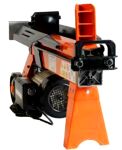



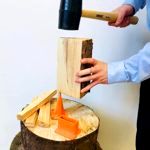
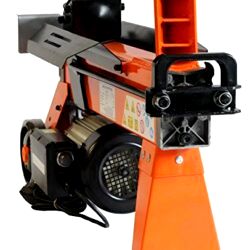
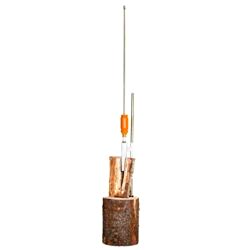
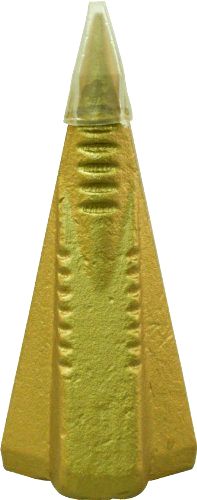
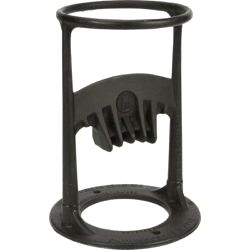
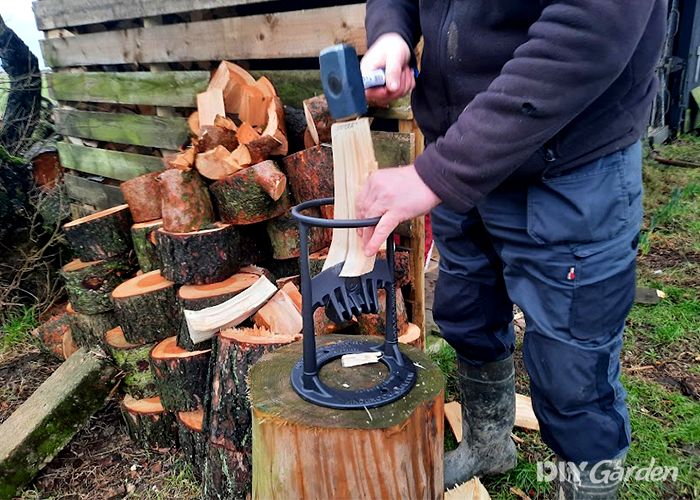
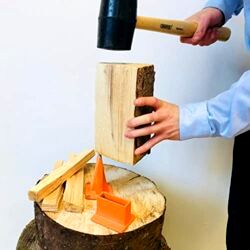
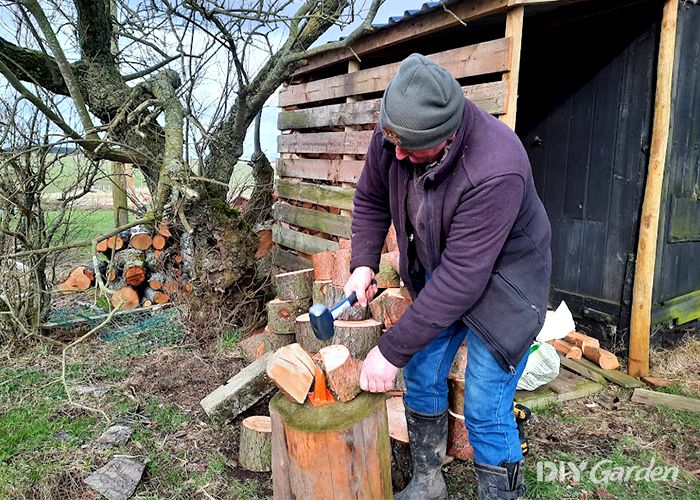
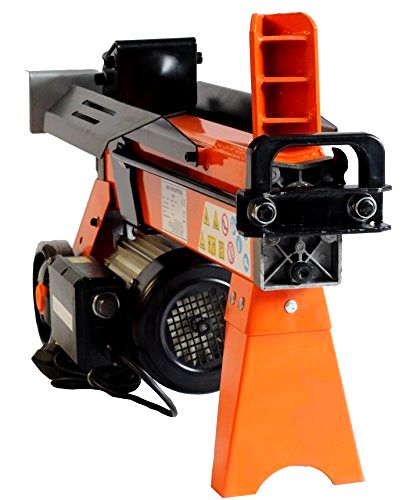




Share